FENTON ART GLASS COMPANY
WILLIAMSTOWN, WEST VIRGINIA
The Fenton Art Glass Company was organized in 1905 by brothers Frank L. and John W. Fenton at Martin’s Ferry, Ohio, a town on the Ohio River across from Wheeling, West Virginia. During the first year or two, Fenton Glass sold hand-decorated glassware that was actually manufactured elsewhere by other glass companies. In 1907 the operation moved to another location on the Ohio River, Williamstown, West Virginia, located in Wood County, where Fenton started making their own glass, and continued to do so for over a century. Fenton specialized in handmade art glass produced by “old style” traditional methods.
Throughout much of Fenton’s earlier years they produced large quantities of hand-blown “iridized” or iridescent glassware, commonly called Carnival Glass, in many colors, shapes, and styles. Over 150 different patterns are known in carnival glass that are attributed to Fenton.

Fenton also produced huge quantities of glass in their so-called “hobnail” pattern which was introduced in 1939. Many, many colors were made including shades of red, yellow, green, amber, cranberry, pink, custard, blue, multi-colored opalescent glass and of course white milk glass.
Fenton applied their own color names to many of the glass colors they produced, including Dusty Rose (pink); Colonial Orange (their version of what many collectors would call Amberina); Sea Mist Green (a shade of blue-aqua); Periwinkle Blue (medium opaque blue); Country Peach (a pink leaning toward a peach shade); Heritage Green (olive or avocado green); Colonial Green (also similar to olive or yellow olive green); Colonial Blue (bright medium sapphire blue); Candleglow Yellow (a light yellow, bright yellow amber or “topaz” color); Colonial Amber (honey amber) and others.
ADVERTISEMENT
Many of their vases, bowls, candy dishes, glass baskets, compotes and other types of glassware feature an attractive “ruffled” or undulating rim, sometimes described as crimped or pleated. Fenton might be best known as a prolific maker of many art glass vases of all types, sizes, patterns and colors, including the popular and often sought after “swung vases”. Another type of vase that has been very popular for years is made in their “Melon” pattern. Fenton also has made a huge variety of decorative and useful rose bowls in many lovely colors, profiles and edge treatments.
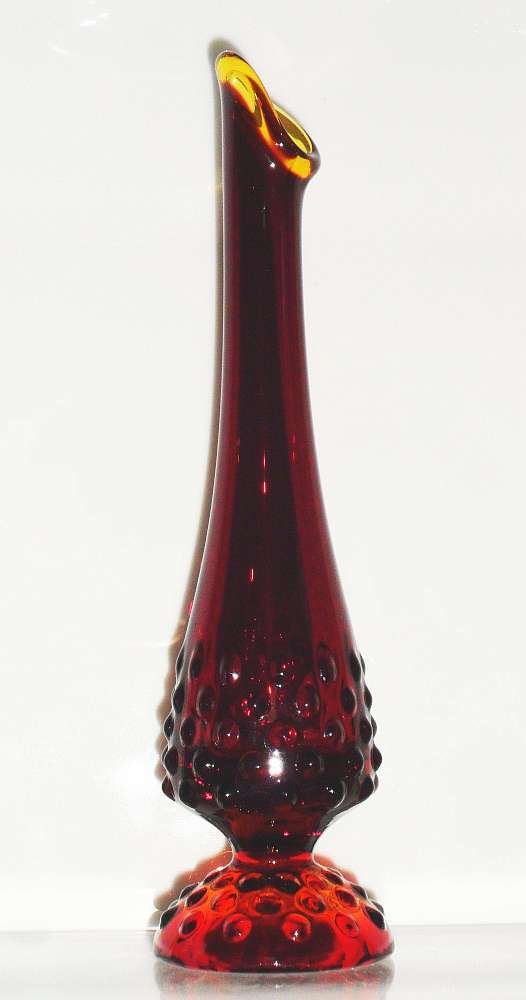
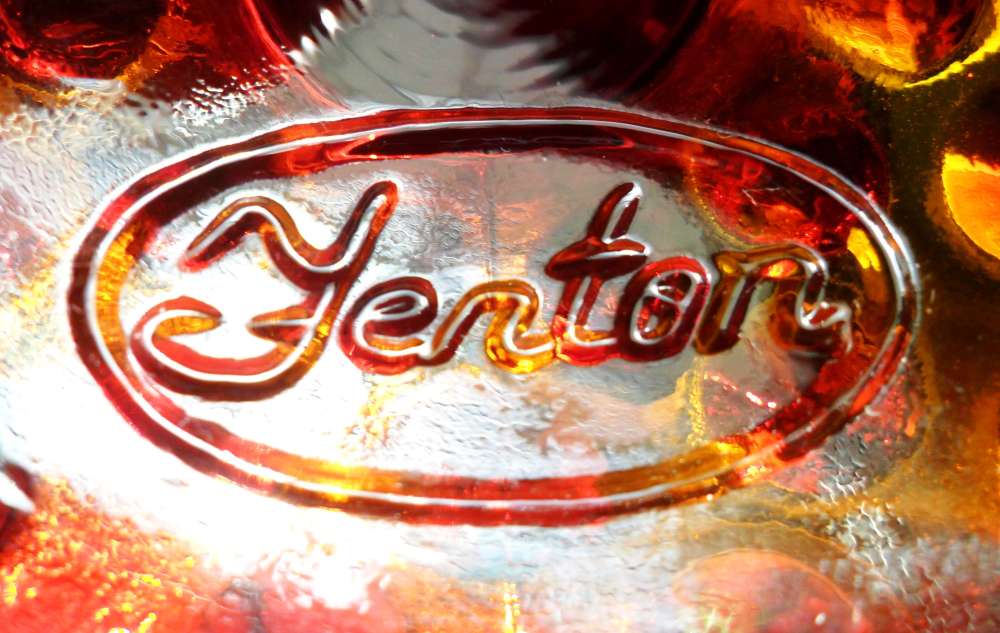
“Fenton in an oval” / “F inside an oval” trademarks
Prior to 1970, most Fenton glassware bore an easily-removable label which, unfortunately, is often missing because of repeated washings or from intentional removal by the original owner. In some cases the owner might have kept the item hidden away in a cupboard, or on display but carefully guarded in a curio cabinet, and the sticker has managed to avoid removal. Needless to say, most glassware that has gone through many repeated washings over the years will no longer bear the original label.
Here is a very good article/webpage showing some of the older paper/foil labels. As explained on this page, information is rather sketchy on older labels, and there are almost no records on labels used prior to 1939: Fenton Paper and Foil Labels
The “FENTON in an oval” mark was introduced on their Carnival glass in the year 1970, to help distinguish it from much earlier Fenton pieces. By 1974, they had instituted that mark on nearly all of their glassware lines and colors. After 1983, the mark “F in a vertical oval” was placed on glass made by Fenton but produced from molds belonging to other glass companies.
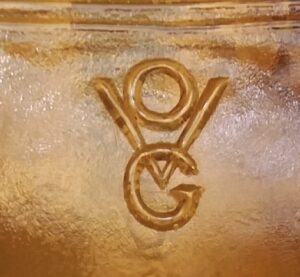
O V G (Olde Virginia Glass) Tableware
Starting in about 1970 or 1971, items in their “Olde Virginia Glass” line (sold by Fenton since about 1960) were permanently marked on the base with a monogram consisting of the letters “O V G” arranged in a vertically overlapping formation (shown above). The Olde Virginia Glass line was sold primarily through wholesalers, discount department stores, and through trading stamp companies. Most, although not all, of the Olde Virginia Glass line are items in the “Daisy & Button” and “Fine Cut and Block” patterns. The OVG mark was used on this glassware until 1979.
(Please see the link farther down on this page which points to a webpage at Fentonfan.com illustrating the various marks used by Fenton over the years).
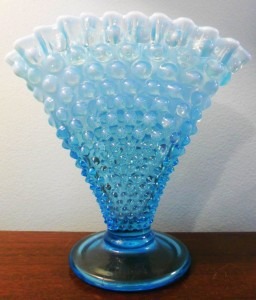
Rumors had circulated for years that Fenton would soon be closing down their glass production. In 2007 it appeared that the end was near, but soon afterward increased business seemed to (somewhat) revitalize the outlook for continued handmade glass production. However, in 2011, Fenton finally discontinued handmade production of their glassware. Since that time they have continued selling some smaller items including beads and handmade artisan glass jewelry.
ADVERTISEMENT
In May 2012, U.S. Glass, a company based in New York, released information indicating they were engaged in talks with Fenton officials and were going to try to buy Fenton and restart production. More here: https://www.glassonline.com/u-s-glass-discussions-on-deal-for-fenton-glass/
From March 20, 2013, here is another article (from prlog.org) which indicates there had been a delay, but plans were still ongoing at that time to restart the factory – with updated products and modern innovations: Fenton at Williamstown to re-open Soon
HOWEVER, evidently those talks did not pan out as hoped, and I haven’t found any further information about what happened in this situation.
This paragraph is from the Fenton Art Glass Company website:
“UPDATE ON FENTON ART GLASS COMPANY and FENTON GIFT SHOP:
Fenton Art Glass Co. ceased traditional glassmaking in 2011. The factory site was purchased by Wood County Schools. Demolition of the factory and original Fenton Gift Shop was completed in 2018 to make way for construction of a new elementary school. Fenton Gift Shop moved to its new Boaz location in July, 2017. ” (From the link below, which is now “dead”, but has been retrieved from the “Wayback Machine” internet archive. This is the last snapshot of the webpage, retrieved by archive.org in May of 2021):
https://web.archive.org/web/20210510180144/https://www.fentonartglass.com/visit-fenton.html
So, although traditional glassmaking stopped in 2011, apparently the Fenton Gift Shop was still operating (as of summer 2018) and was selling both vintage Fenton glassware, as well as some new glass made by Mosser Glass Company in the old Fenton molds. Also, a line of glass jewelry was being sold there.
Here’s a great article from the Parkersburg, WV News and Sentinel about a reunion held at the factory grounds in April of 2017, with nearly 200 former employees gathered for reminiscing, touring the plant, and refreshments. Some photos are posted of the interior of the factory where the glass was actually made!
Fenton’s Last Farewell – News and Sentinel Article
Below is a link to a video about Fenton Glass, posted on Youtube. Presumably this was recorded sometime in 1992. The video shows workers actually making different handmade items, and shows the various steps employed in producing these beautiful pieces of glassware:
Fenton Glass Video – Circa 1992
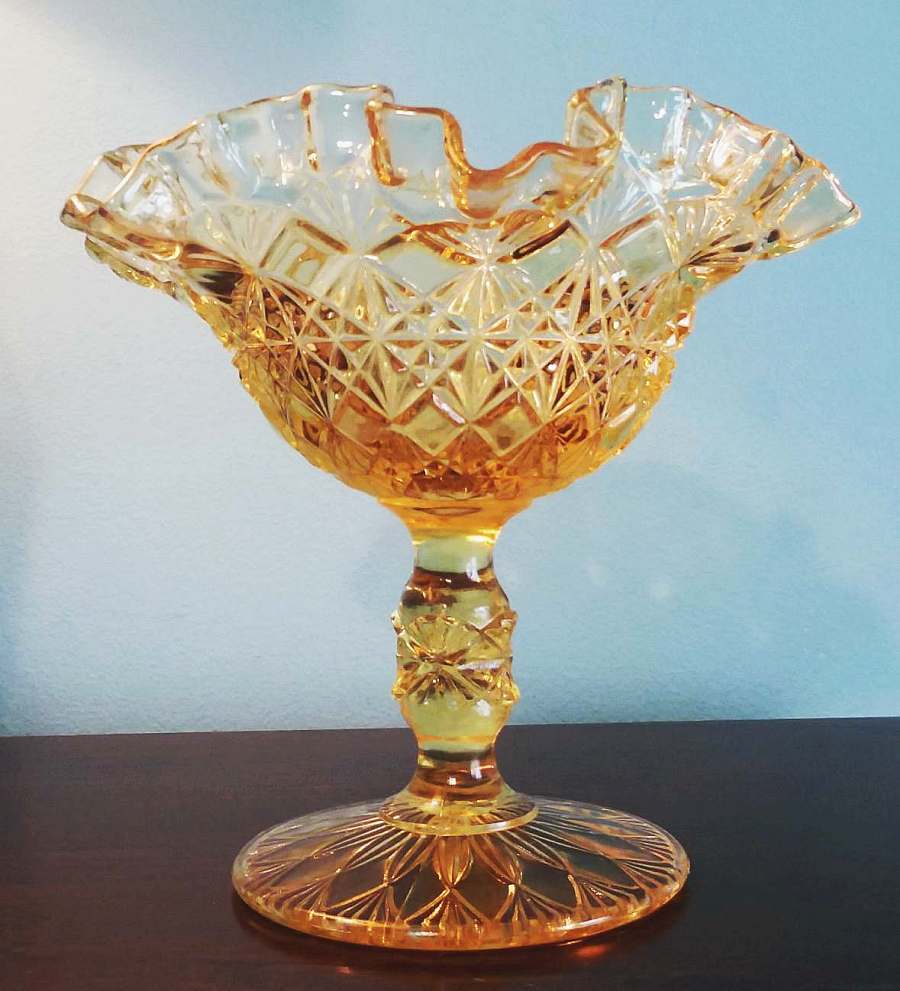
VALUES / PRICES
In general, on this website I’ve always tried to concentrate primarily on the background and history aspects of glass and glassware being discussed, with little or no emphasis or information on current market values or trends. Nevertheless, in the case of Fenton, I felt I should address this subject, albeit briefly. Many owners of Fenton glassware (new, casual or even longtime collectors, or just someone who has a piece or two) attempt to find information about what their glass is worth, or try to search online for input on market values and price trends.
I have mentioned this subject within replies to comments posted on the site, so please bear with me, but it might bear repeating: One of the best ways, (if not the best way) to get a fair idea on current pricing trends for Fenton glassware (or other types of glass, or any antiques or collectibles, for that matter) is to search the ebay.com auction/sales site.
Using the “Advanced search” page, a good way to find information on values is to type in relevant descriptive keywords that might come to mind for a specific piece or a very similar piece (such as “blue hobnail Fenton glass bowl” or “Fenton vase pink glass” but without the quotation marks) AND search with the “Completed Items” option box checked. This will bring up listings that have already ended, and the ACTUAL SELLING price is shown (assuming the piece actually sold). If an item is shown as having been listed repeatedly over many weeks or months, with no sale, this could be an indication that the beginning bid (minimum bid, or BUY IT NOW price) the seller has set is too high – higher than what the current market will bear.
In many cases the ebay seller is honestly doing the best he or she can, trying to sell the piece at what they feel is a fair price. In some cases the seller simply has no idea what a piece is worth, and “wings it” by listing a piece with an unrealistically high minimum bid. Sometimes the shipping charges are inflated, and bidders choose not to bid on an item if they feel the shipping cost will make the total purchase price higher than what they are willing to pay.
If a seller is located on the west coast and the buyer is several thousand miles away, or vice versa, the shipping cost will be higher, and that might dissuade a prospective bidder from placing a bid on an item.
Ultimately, it comes down to the collector (or anyone trying to find more info on values) to sift through the information presented and come to their own conclusions on average market value by studying a number of different listings over time.
The “average market values” for a lot of antique, vintage and collectible glassware has, in general, dropped somewhat over recent years. A particular item priced in an antique mall may be found to be priced higher OR lower than on an online venue such as ebay. The internet has revealed the existence of large numbers of Fenton glass items now available for sale that had not seen the light of day in previous years. Cases like this will usually cause a decrease in prices, simply because of the law of supply and demand.
ADVERTISEMENT
There are a number of books on Fenton Art Glass Company (see Bookfinder.com search, below), and some of them include pricing information. In some cases the prices given may be higher than reality would dictate in the current collectibles marketplace. In the case of online purchases I would simply suggest the reader keep in mind the old saying “Buyer Beware”. Look at pictures very carefully, and don’t hesitate to ask for more pics or info if there are any questions on condition or possible damage to a piece. Any damaged glass items will be of less (often, MUCH less) value than a similar item in mint or very near mint condition.
REFERENCE BOOKS ABOUT FENTON GLASS
Many reference books have been published over the last several decades on Fenton Art Glass Company, with detailed information on it’s patterns, glass colors produced, history, etc. Some of these include price guides. Instead of listing some of these books here, I am taking a different approach: One of the best ways to find books and compare prices on used and new copies of those books (or any books, for that matter, on any subject) is to search the bookfinder.com website, where millions of books have been indexed into their database. Here is a URL that gives the results on a keyword search using just the query FENTON GLASS. The link is here: Fenton Glass on Bookfinder.com
Hopefully this search will help readers who are interested in adding a book on Fenton glass (or several) to their library. Clicking on any title result will bring up details on bookseller, author, year published, edition, number of pages, total price including shipping, etc.
REFERENCES (on the Web) on FENTON GLASS
RubyLane.com webpage article (“A beginner’s Guide to Collecting”) with good info on collecting Fenton glass, including information on the kinds of glass they made, and some info on marks. RubyLane Article on Collecting Fenton Glassware
This webpage shows the mark / logo variations as used by Fenton Art Glass:
http://fentonfan.com/logo.html
TheSpruceCrafts.com webpage with info on Fenton, they show a number of nice photographs of colorful Fenton glass pieces:
Fenton Value Guide – thesprucecrafts.com
TheGlassMuseum.com ~ webpage on Fenton Glass: The Glass Museum
The National Fenton Glass Society webpage: National Fenton Glass Society
This page (on the fentonaddict.com site) discusses the finer details in distinguishing the “Hen on Nest” candy dishes made by Fenton:
Features and Characteristics of Fenton Glass Hens.
Wikipedia article about Fenton Art Glass.
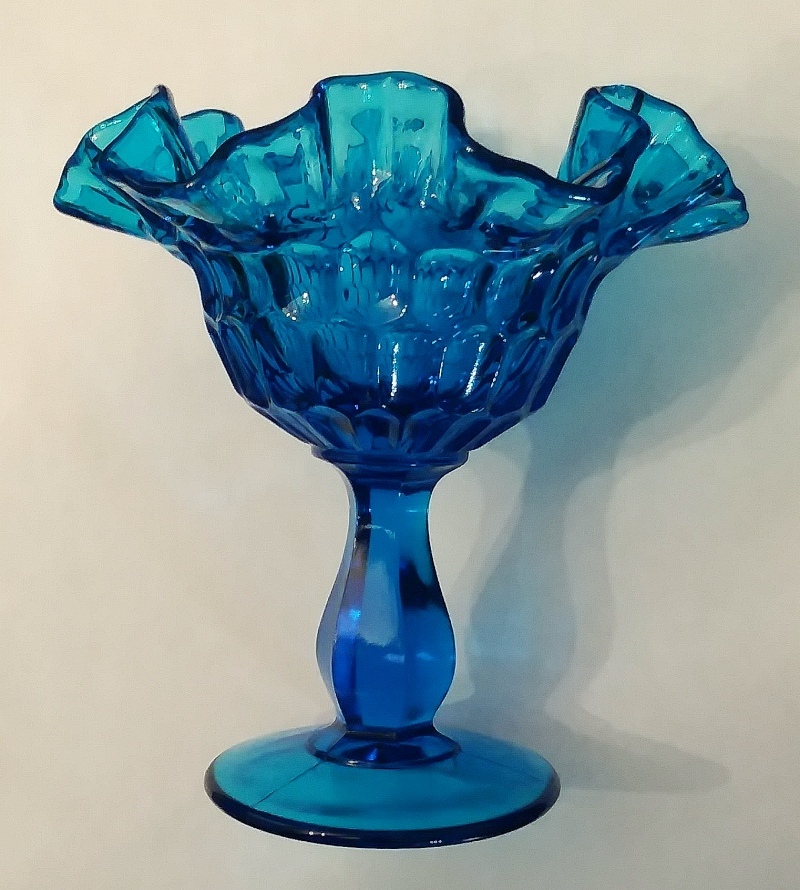
Keyword search on Ebay: Fenton Glass on ebay
Please click here to go to my website Home Page.
Click here to go to the GLASS BOTTLE MARKS pages, with an extensive alphabetical list of glass manufacturers’ marks seen on bottles, jars, insulators, tableware and other items.
Here’s my article with some basic information about EAPG (Early American Pattern Glass).
Click here for a basic summary on Depression Glass.
Please check out my page on collectible antique and vintage MILK GLASS, a summary / overview that mentions Fenton as well as other glass companies that have made milk glass and other opaque glass over the years.
ADVERTISEMENT

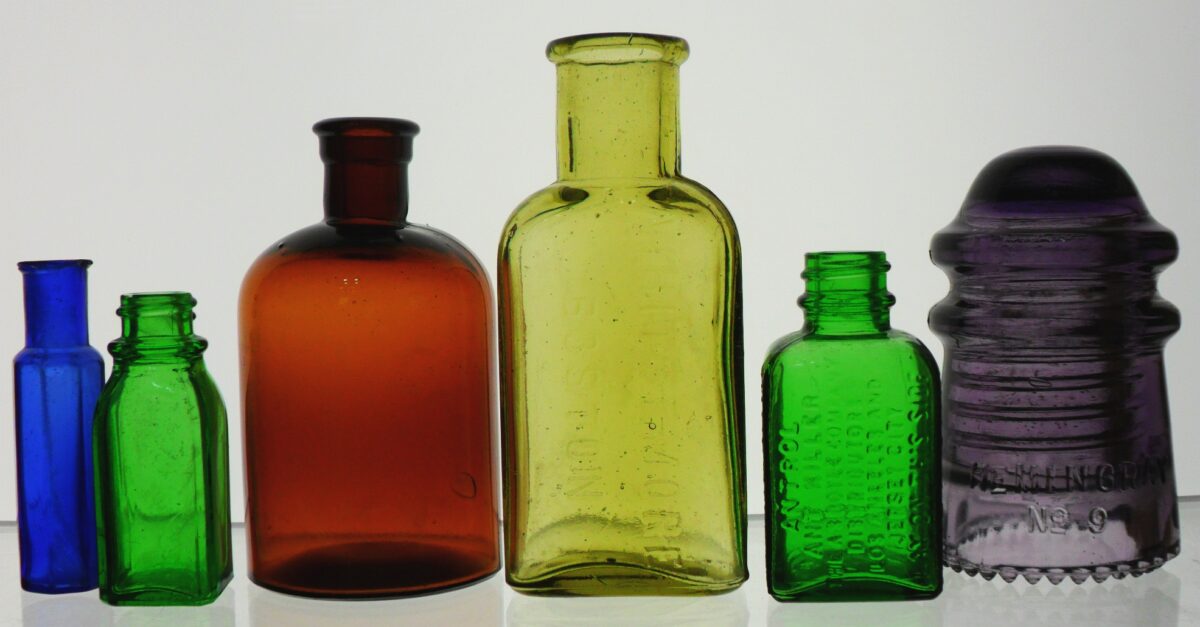
For what it’s worth;
Fenton never called any of their glassware Amberina, they called their glass of that coloration Colonial Orange.
Amberina is not a special glass type. It was only a registered product name used by the New England Glass Co., and then by Libbey when they took over. Other companies from that era had their own marketing names for their glass of that coloration like Rose Amber etc…True Amberina was made using gold in the batch and the color shades from true amber to a cranberry/fuchia color, not yellow to red., which was made using selenium, not gold. https://ibb.co/xsvZqwW The old type name for glass that shades from one color to another was called bi-partite glass and that includes Amberina.
Also; The Fine Cut & Block pattern was not part of Fenton’s regular line. It was from a line of old patterns they called Olde Virginia Glass, which were made using molds that once belonged to older, out of business glass companies , King Glass in the case of the Fine Cut & Block pattern.
The Olde Virginia Glass line was started in 1969 and in 1970 they began putting the OVG logo https://ibb.co/jzQ5P6N on it, same year they began using the Fenton logo on their regular glass line. Olde Virginia Glass was sold/traded at S & H Green Stamps redemption centers.
Hello John,
Thank you very much for your post and for the information. I will make some edits including adding the color name “Colonial Orange” to the article. In the context of this article I use “Amberina” merely as the most commonly accepted name used by most glass collectors for that typical color (or coloration) of glass, although, as you noted, there are variations in the exact color shades, glass formula ingredients, and names applied to the coloration by different glass companies.
Best regards,
David
Is there a list of marks on carnival glassware available?
Hi Beverly,
Most Carnival glass is not marked, but here is a page from David Doty’s website on Carnival Glass, illustrating some of the marks likely to be found:
http://www.ddoty.com/makermarks.html
Hope this helps!
David
I just found this site–thank you so much for all your work!
I was looking for information on the Pine Glass Manufacturing company that operated in Okmulgee, OK from 1927-1929. There doesn’t seem to be much information out there, but your site added a bit that I didn’t know.
Thanks again.
Frances, I don’t have any info other than what is on my site.
Best regards,
David